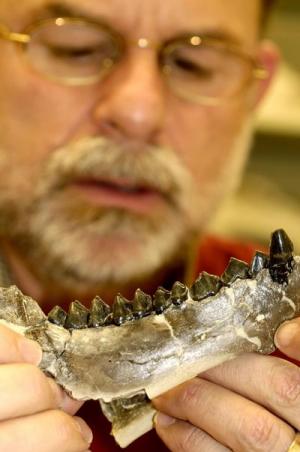The largest climate change in central North America since the age of the dinosaurs 65 million years ago, a temperature drop of nearly 15 degrees Fahrenheit, is documented within the fossilized teeth of horses and other plant-eating mammals, a new study reveals.
The overwhelming majority of previous climate-change studies on the 400,000-year transition from the Eocene to the Oligocene epochs, about 33.5 million years ago, focus on marine environments, but University of Florida vertebrate paleontologist Bruce MacFadden and his colleagues turned their attention to fossils from the Great Plains.
 University of Florida vertebrate paleontologist Bruce MacFadden examines a fossil oreodont jaw from Nebraska in the Florida Museu
University of Florida vertebrate paleontologist Bruce MacFadden examines a fossil oreodont jaw from Nebraska in the Florida Museu